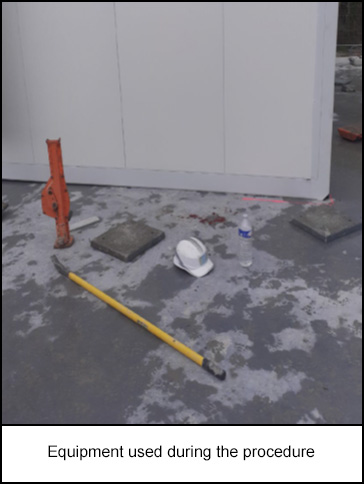-
What happened?
The operation consists of offloading three containers from transport trucks and placing them on a concrete slab.
Each container is offloaded by crane and placed on ‘rollers’ so that it can be placed in its final position. Jacks are used to offload the trolleys.
The container is removed using the jacks and placed on wedges positioned at each corner. These wedges allow the jacks to be removed.
The operators use a crowbar to slightly raise the module and remove the wedges one by one at each corner.
The container dropped abruptly onto the crowbar, which suddenly lifted underweight and struck the face of the operator.

-
Why did it happen?
The concrete slab is not resistant enough to support the weight of the crane, and the surrounding area is not accessible to the crane.
When the final container was being moved using the crowbar that was lying under the container, the composite slab broke.
The heavy weight of the container and lack of lifting or handling equipment. Human presence for manual handling.
Removal of the wedge under the container. Using a crowbar to remove the container from its wedge.
Incorrectly positioned wedge and the wedge broke under the weight. Crowbar slipped/moved.

-
What did they learn?
Revise operating procedures to incorporate the use of appropriate lifting equipment and to detail safe methods for removing wedges and other supports.
Conduct routine inspections and maintenance of lifting equipment to ensure it is in good working condition and suitable for the tasks at hand.
Enhance risk assessment processes to identify and mitigate potential hazards more effectively. This should include evaluating the stability and load-bearing capacity of support structures.
Develop and practice emergency response plans to address potential incidents, ensuring quick and effective action can be taken in case of an emergency.
Implement regular training sessions focusing on safe lifting techniques, equipment use, and emergency response procedures.

-
Ask yourself or your crew
How can something like this happen here?
How do we know we using the most appropriate and safest equipment for the tasks we perform?
What risks haven’t we identified?

Add to homescreen
Content name
Select existing category:
Content name
New collection
Edit collection
What happened?
The operation consists of offloading three containers from transport trucks and placing them on a concrete slab.
Each container is offloaded by crane and placed on ‘rollers’ so that it can be placed in its final position. Jacks are used to offload the trolleys.
The container is removed using the jacks and placed on wedges positioned at each corner. These wedges allow the jacks to be removed.
The operators use a crowbar to slightly raise the module and remove the wedges one by one at each corner.
The container dropped abruptly onto the crowbar, which suddenly lifted underweight and struck the face of the operator.

Why did it happen?
The concrete slab is not resistant enough to support the weight of the crane, and the surrounding area is not accessible to the crane.
When the final container was being moved using the crowbar that was lying under the container, the composite slab broke.
The heavy weight of the container and lack of lifting or handling equipment. Human presence for manual handling.
Removal of the wedge under the container. Using a crowbar to remove the container from its wedge.
Incorrectly positioned wedge and the wedge broke under the weight. Crowbar slipped/moved.
What did they learn?
Revise operating procedures to incorporate the use of appropriate lifting equipment and to detail safe methods for removing wedges and other supports.
Conduct routine inspections and maintenance of lifting equipment to ensure it is in good working condition and suitable for the tasks at hand.
Enhance risk assessment processes to identify and mitigate potential hazards more effectively. This should include evaluating the stability and load-bearing capacity of support structures.
Develop and practice emergency response plans to address potential incidents, ensuring quick and effective action can be taken in case of an emergency.
Implement regular training sessions focusing on safe lifting techniques, equipment use, and emergency response procedures.
Ask yourself or your crew
How can something like this happen here?
How do we know we using the most appropriate and safest equipment for the tasks we perform?
What risks haven’t we identified?
Operators used a crowbar to slightly raise a module and remove wedges one by one at each corner. A container dropped abruptly onto the crowbar, which suddenly lifted under weight and struck the face of the operator.











